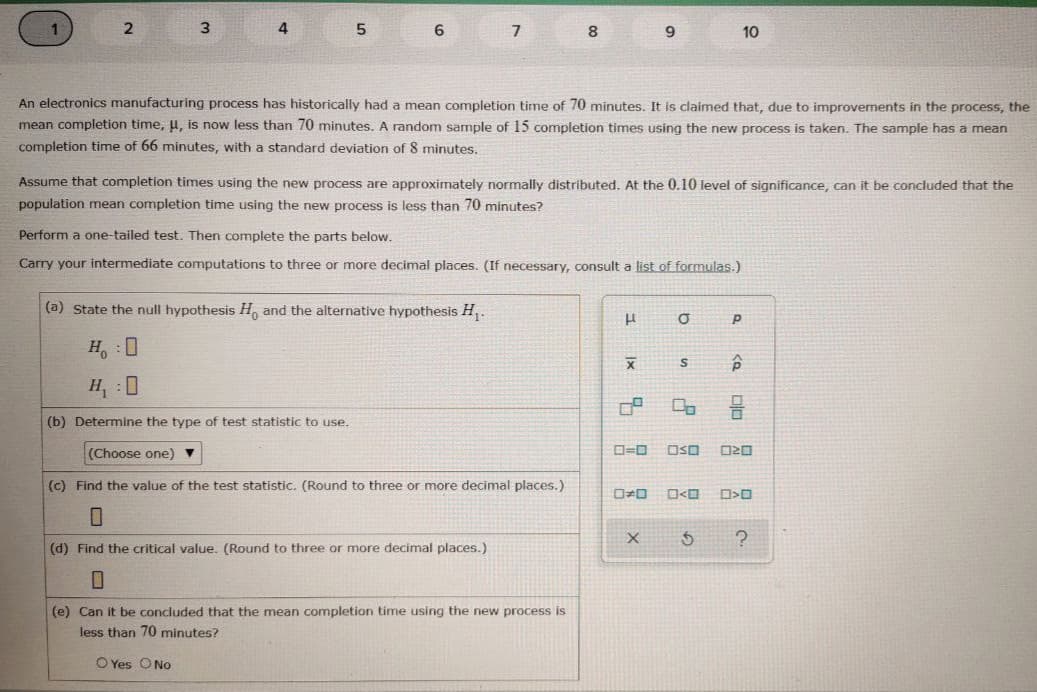3 4 5 6 7 8 9 10 An electronics manufacturing process has historically had a mean completion time of 70 minutes. It is claimed that, due to improvements in the process, t mean completion time, u, is now less than 70 minutes. A random sample of 15 completion times using the new process is taken. The sample has a mean completion time of 66 minutes, with a standard deviation of 8 minutes. Assume that completion times using the new process are approximately normally distributed. At the 0.10 level of significance, can it be concluded that the population mean completion time using the new process is less than 70 minutes? Perform a one-tailed test. Then complete the parts below. Carry your intermediate computations to three or more decimal places. (If necessary, consult a list of formulas.) (a) State the null hypothesis H and the alternative hypothesis H,. H, :0 (b) Determine the type of test statistic to use. (Choose one) ▼ D=0 OSO (c) Find the value of the test statistic. (Round to three or more decimal places.) ロロ
3 4 5 6 7 8 9 10 An electronics manufacturing process has historically had a mean completion time of 70 minutes. It is claimed that, due to improvements in the process, t mean completion time, u, is now less than 70 minutes. A random sample of 15 completion times using the new process is taken. The sample has a mean completion time of 66 minutes, with a standard deviation of 8 minutes. Assume that completion times using the new process are approximately normally distributed. At the 0.10 level of significance, can it be concluded that the population mean completion time using the new process is less than 70 minutes? Perform a one-tailed test. Then complete the parts below. Carry your intermediate computations to three or more decimal places. (If necessary, consult a list of formulas.) (a) State the null hypothesis H and the alternative hypothesis H,. H, :0 (b) Determine the type of test statistic to use. (Choose one) ▼ D=0 OSO (c) Find the value of the test statistic. (Round to three or more decimal places.) ロロ
MATLAB: An Introduction with Applications
6th Edition
ISBN:9781119256830
Author:Amos Gilat
Publisher:Amos Gilat
Chapter1: Starting With Matlab
Section: Chapter Questions
Problem 1P
Related questions
Question
Find all the answer for this problem. Answer letter a to e pls. I don't want to waste my money here.

Transcribed Image Text:1
2
4
5
6
7
8
9
10
An electronics manufacturing process has historically had a mean completion time of 70 minutes. It is claimed that, due to improvements in the process, the
mean completion time, u, is now less than 70 minutes. A random sample of 15 completion times using the new process is taken. The sample has a mean
completion time of 66 minutes, with a standard deviation of 8 minutes.
Assume that completion times using the new process are approximately normally distributed. At the 0.10 level of significance, can it be concluded that the
population mean completion time using the new process is less than 70 minutes?
Perform a one-tailed test. Then complete the parts below.
Carry your intermediate computations to three or more decimal places. (If necessary, consult a list of formulas.)
(a) State the null hypothesis H, and the alternative hypothesis H.
H, : 0
H :0
(b) Determine the type of test statistic to use.
(Choose one) ▼
OSO
(c) Find the value of the test statistic. (Round to three or more decimal places.)
(d) Find the critical value. (Round to three or more decimal places.)
(e) Can it be concluded that the mean completion time using the new process is
less than 70 minutes?
O Yes ONo
Expert Solution
This question has been solved!
Explore an expertly crafted, step-by-step solution for a thorough understanding of key concepts.
Step by step
Solved in 4 steps

Recommended textbooks for you

MATLAB: An Introduction with Applications
Statistics
ISBN:
9781119256830
Author:
Amos Gilat
Publisher:
John Wiley & Sons Inc

Probability and Statistics for Engineering and th…
Statistics
ISBN:
9781305251809
Author:
Jay L. Devore
Publisher:
Cengage Learning

Statistics for The Behavioral Sciences (MindTap C…
Statistics
ISBN:
9781305504912
Author:
Frederick J Gravetter, Larry B. Wallnau
Publisher:
Cengage Learning

MATLAB: An Introduction with Applications
Statistics
ISBN:
9781119256830
Author:
Amos Gilat
Publisher:
John Wiley & Sons Inc

Probability and Statistics for Engineering and th…
Statistics
ISBN:
9781305251809
Author:
Jay L. Devore
Publisher:
Cengage Learning

Statistics for The Behavioral Sciences (MindTap C…
Statistics
ISBN:
9781305504912
Author:
Frederick J Gravetter, Larry B. Wallnau
Publisher:
Cengage Learning

Elementary Statistics: Picturing the World (7th E…
Statistics
ISBN:
9780134683416
Author:
Ron Larson, Betsy Farber
Publisher:
PEARSON

The Basic Practice of Statistics
Statistics
ISBN:
9781319042578
Author:
David S. Moore, William I. Notz, Michael A. Fligner
Publisher:
W. H. Freeman

Introduction to the Practice of Statistics
Statistics
ISBN:
9781319013387
Author:
David S. Moore, George P. McCabe, Bruce A. Craig
Publisher:
W. H. Freeman